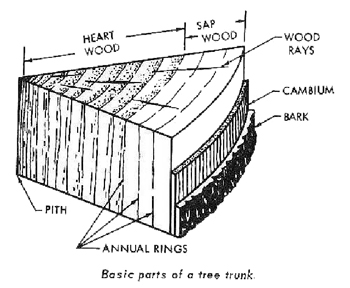Introduction
Wood, a renewable resource, is a desirable material for construction and is used in the manufacture of items such as railroad ties and utility poles. Chemically, wood is composed of
- complex carbohydrates (cellulose and hemicellulose),
- lignin - composed of phenolic compounds,
- extractives, and
- mineral matter.
The cell walls of wood fibers are made of bits of cellulose surrounded by hemicellose. Both of these sugars are made of carbon, oxygen, and nitrogen. Lignin acts as a glue to keep the fibers together. Cellulose is one of the most abundant organic compounds on earth so wood is an attractive resource for various species of fungi, insects, and bacteria -- natural organisms of breakdown and decay. Wood preservatives are pesticides that can protect wood from attack and decay by these organisms. Proper application of preservatives can prolong the service life of wood for many years.
An estimated 10% of the timber cut each year in the United States is used to replace wood that has failed, often due to attack by fungi, bacteria, insects, or marine borers. Wise use of chemicals to preserve or temporarily protect wood can substantially increase service life. This significantly reduces wood losses and helps to conserve timber resources. Substitution of alternate structural materials for pressure-treated wood currently used would cost the US. economy $4.5 to $6.3 billion dollars each year and force us to use more of our nonrenewable resources. Similarly, failure to use anti-sap stain chemicals could cause unprotected, high quality lumber to lose as much as 50% of its value during processing and shipment.
A crosscut of most trees shows a zone of lighter sapwood surrounding a core of darker heartwood. Fast growing trees usually have deeper sapwood than slow-growing trees. About 90% of wood is minute, hollow fibers oriented lengthwise along the tree stem. Water and nutrients move vertically through these fibers, which also serve as a means of support. The remaining 10% of wood is composed of short, hollow, brick-shaped cells that are oriented from the bark toward the center of the tree. They are like ribbons or rays of unequal height and length. These rays carry the food manufactured in the leaves down the inner bark to the growing tissues between the bark and the wood.

(image: HobbitHouseInc.com)
Minute passageways called pits interconnect the cavities of adjacent cells. While these pits often act as simple holes through adjacent cell walls, their structure is more complicated and they are sometimes obstructed. Water in the living tree moves from cell to cell by means of these pits. These pits often help the movement of water along in drying lumber or utility poles. These pits also may aid in the impregnation of wood with wood preservatives.
The economic importance of wood destroying organisms (WDO) varies with location, environmental conditions, tree species, and differences between the sapwood and heartwood regions within a given tree.

Wood pole decay hazard risk (1 = lowest decay risk, 5 = highest)
(image: osmose.com)
Sapwood, located next to the growing cambium layer just under the bark, represents the living part of the tree. It is less resistant to attack than the heartwood. The
inner heartwood near the center of the tree is less resistant than the outer layers of heartwood that contain preservative chemicals such as phenols.
All wood species are susceptible to attack by wood-destroying organisms (WDO) but some are less susceptible (more resistant) than others depending on natural preservatives that they contain. The USDA Forest Service has grouped woods according to decay resistance. However, resistance is a relative term. Wood with high natural resistance is not immune to attack. Heartwoods of black locust, redwood and western red cedar have a reputation of being decay resistant. Heartwood of other tree species may exhibit lesser amounts of toxicity of decay fungi. Sapwood of all species does not have natural decay resistance.
Older, slow-growing trees from stands of virgin timber generally contain higher concentrations of natural preservatives than do younger faster-growing replacement trees. Consequently, older structures tend to be more durable than newer wood structures. The treatment of wood with chemical preservatives extends and supplements the natural preservatives in wood. Crossties, poles, posts, and other wood products in contact with the ground or that are exposed to the weather must be protected with preservatives to ensure a reasonable service life. Wood products not in contact with the ground may be treated as a precautionary measure even though they are not exposed to moisture and weather.
[return]



